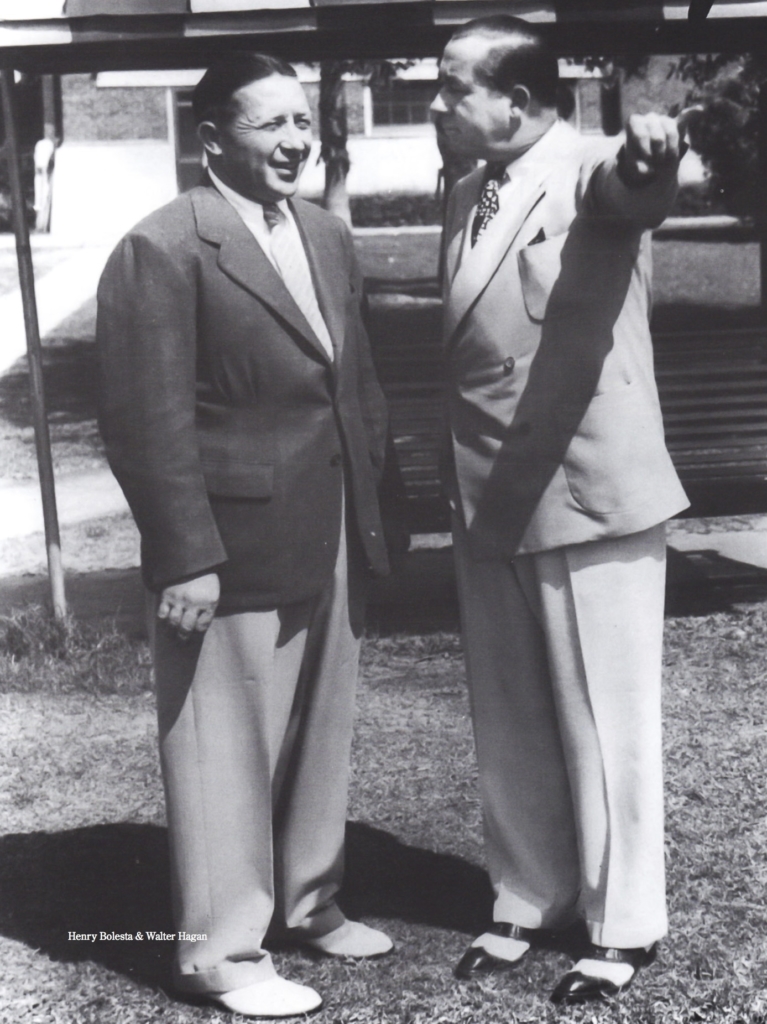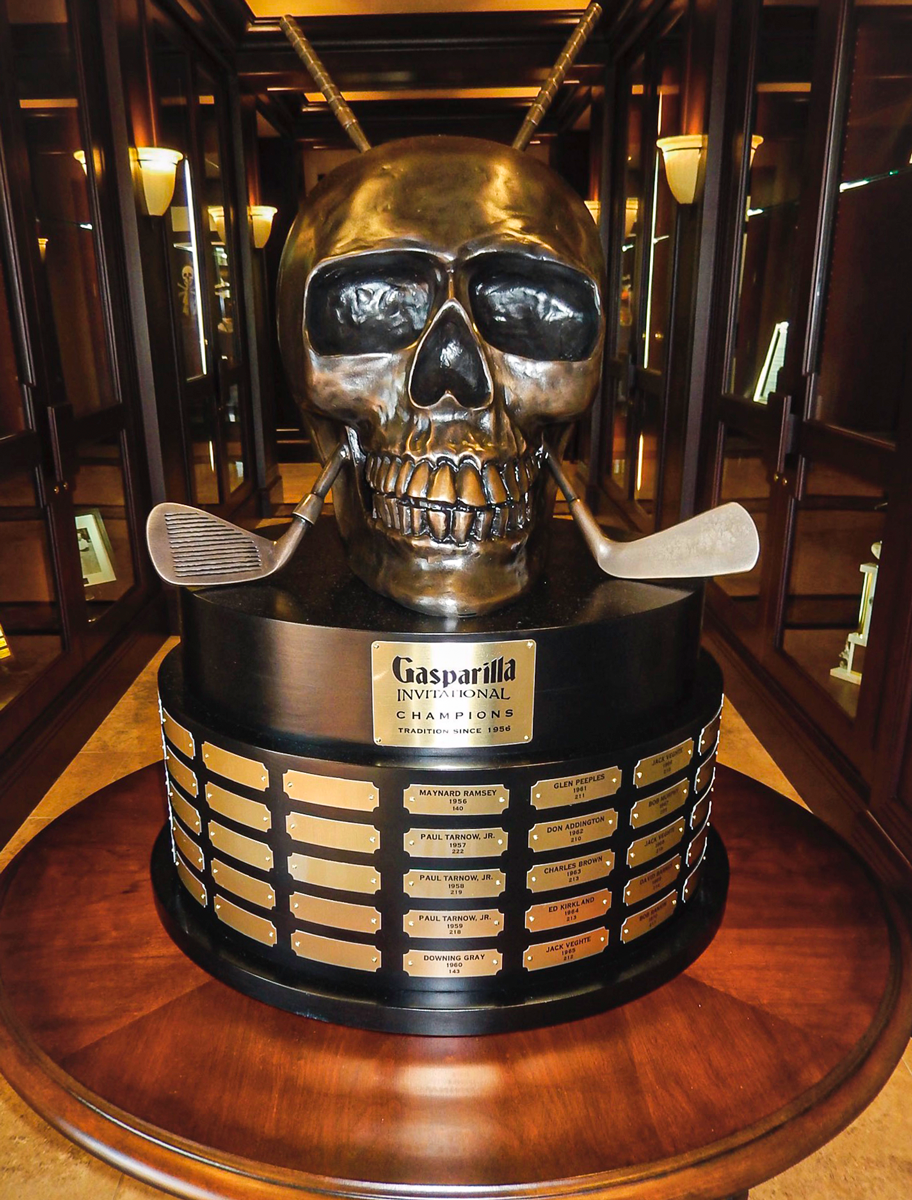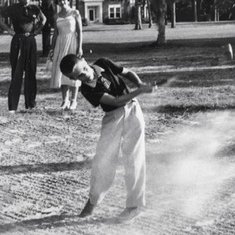Gasparilla Invitational History
The Gasparilla Invitational’s roots go back to The Gasparilla Open, which began in 1932 as a PGA match play event, and ran for four years through 1935.
The winner in 1932 was PGA Golf Hall of Fame member Paul Runyan (29 PGA wins, 2 Majors). At that time, the golf tournament was closely tied to the Ye Mystic Krewe of Gasparilla (YMKG), which annually sponsors a February “pirate invasion” and Mardi Gras-like parade for the City of Tampa. As the winner, Runyan was awarded a bag of gold coins worth $962 by the YMKG Captain. In 1933 and 1934, the Tournament was won by Denny Shute (16 PGA wins, 3 Majors) in medal competition, with Shute besting the likes of Hall of Famers Gene Sarazen and Horton Smith. After his ’33 Gasparilla victory, Shute went on to win the British Open on the Old Course in St. Andrews, Scotland. Other contestants in that field were accomplished local players, Palma Ceia member Harry Root Jr. and Palma Ceia head professional, Henry Bolesta. Many other famous playing professionals competed in those years including Walter Hagen, Lloyd and Ray Mangrum, Henry Picard, Ralph Guldahl and Johnny Revolta, who captured his first professional win at Palma Ceia.
Up until 1935, The Gasparilla Open was the top money PGA tournament in the United States with an average purse of four thousand dollars. In 1935, the Tournament Committee changed the format and limited the payout of prize money to PGA professionals only. The committee also banned the popular pari-mutual betting which was quite common at the time.

Walter Hagen’s Final Win
One of the greatest golfers of all time, “Sir Walter” Hagen popularized professional golf and brought it into the mainstream of global sport. In 1919, some 16 years before the 1935 Gasparilla, 26 year old Walter Hagen was employed as Palma Ceia’s winter professional, with the Club also serving as his home course as he played the Florida winter circuit. At that time he only had 3 tournament wins, although one of them was the 1914 U.S. Open. When Hagen returned to Palma Ceia for the 1935 Gasparilla, he was the holder of 43 PGA titles and 11 Majors, and was recognized as the greatest professional golfer of his era. He was also 42 years old and had not won a tournament in 2 years. Nevertheless, the organizers held a spot for him, although they were unsure if he would attend, because he did not show up for any practice rounds.
In his autobiography chapter entitled “Gasparilla,” Hagen recounts how at dawn on the morning of the first round of the tournament, he found himself across the Bay at the Belleview-Biltmore Hotel, still attired in his tuxedo after an all-night party. To prepare for his upcoming play, he sent his chauffer into a field beside the hotel to retrieve a few practice shots. After topping three shots in a row, he decided that was enough practice, and headed off to Tampa, briefly interrupted by a flat tire on the Gandy Bridge. Just two minutes before his 9:00 tee time, Hagen was spotted as he sauntered up to the first tee to play without a single practice swing or putt. He then proceeded to shoot a course record 64 and take the tournament lead.
Back then, the final two rounds were played consecutively on the third day of the Tournament. After making a seven on the short par five 18th hole in the 3rd round, Hagen retired for a brief respite only two up on the field. He then posted a 38 on the front side of the final round which put him in a tie with just nine holes left to play. By the time he stepped onto the par three 17th tee, he was one stroke behind the clubhouse leader, Clarence Clark, and appeared likely to lose, especially after his tee shot landed 45 feet from the pin. However, as the New York Times reported the next day, he “nonchalantly” holed the long birdie putt before a cheering crowd to tie for the lead. He then birdied 18 with an up and down from the bunker to capture his final PGA individual victory.
The Modern Gasparilla

In 1956, the Gasparilla Invitational resumed as a strictly amateur event. The Tournament was won that year by Palma Ceia member Maynard Ramsey with an even par, two day score of 140. Over the following years and to this very day, many U.S. Amateur, U.S. Mid-Amateur champions as well as then current Walker Cup players have chosen to add this tournament to their playing schedules. Top amateurs from around the country have often come to Palma Ceia to test their skills against our local players and other regional champions. The 1960 winner was Downing Gray, a three time Walker Cup player. Mr. Gray also won seven consecutive tournaments while in college at Florida State and played in the Masters for six consecutive years winning the “silver cup” for low amateur two of those years. The 1976 Champion was former U.S. Amateur Champion Buddy Alexander, the former golf coach at the University of Florida. The 1981 winner was young Hal Sutton of Shreveport, Louisiana who hoisted the trophy after scoring a three over par 213 in the three day event. It was the last event in which Hal Sutton would play as an amateur before moving on to a successful PGA career that would culminate with his selection as a U.S. Ryder Cup Captain.
When the Tournament became more connected to a Mid- Amateur event format, the rules stipulated that a participant had to be at least 25 years of age and no longer in college to compete. An exemption would be granted if one was a current U.S. Amateur Champion. Nathaniel Crosby, son of the legendary crooner and golf enthusiast Bing Crosby, used that exemption to play in the 1982 event which was won by Dick Siderowf with a three day total of one over par. Siderowf was a seasoned competitor and a perennial nationally ranked amateur with two British Amateur victories on his playing resume.
A series of U.S. Mid-Amateur Champions have participated and won the Gasparilla Invitational including top amateurs Tim Jackson, Spider Miller and Danny Green. It was not uncommon for USGA Champions to compete in the Gasparilla Invitational as a way to prepare them for the fast putting surfaces and pressure filled environment that they would encounter a few weeks later in April at The Masters in Augusta, Georgia.
The quick putting surfaces and narrow fairways have fiercely protected par in most years. In 1967, local Mulberry legend and former U.S. amateur Champion, Bob Murphy, carved an amazing 5 under par 205 through the Palma Ceia pines to win going away. That tournament record was not equaled until 1988 when David Smith matched Murphy’s total of five under par. In 2005, Peter Dachisen, currently a PGA Tour rules official, set a new record by shooting a six under 204 in his lap of that year’s field and setting the single round scoring record with an eight under 62. Dachisen has won five Gasparilla titles. The only other five time winner is Jack Veghte of Clearwater, Florida. Dachisen’s tournament record was bested in 2018 by Marc Dull with a seven under 203 and by Mike Finster in 2019 with a remarkable eight under 202.
As the host course, it should be noted that Palma Ceia Golf and Country Club has also had some of its own members win the tournament. Paul Tarnow Jr. won three times in the 1950’s, Charlie Brown won in 1963 and Doug Lacrosse, a three time player of the year in the Florida State Golf Association, won the 1991 event.
Palma Ceia member Fred Ridley, a former U.S Amateur Champion, Walker Cup player/captain, USGA President, and current Augusta National Chairman has participated in the tournament and served as its Chairman.
While it is considered a serious and elite amateur golf event, the Gasparilla has always offered an array of fun parties and social events. The final round is well attended as hundreds of Club Members and guests come out to watch the field of elite amateur golfers compete for the trophy and enjoy the hospitality stations on the course. The winner of this tournament carries not only the prestige of that singular victory but has his name linked to the history of this outstanding event for the rest of his career.
In the beginning…
The first private golf and country club in the Tampa Bay area, Palma Ceia was born in 1916 during a time when the game of golf was growing rapidly and Tampa was in the midst of a real estate boom. In 1915, the Tampa Bay Land Co., owned by James F. Taylor, began to promote Palma Ceia Park, which at that time included the area south of the club to Bay to Bay, and from Mac Dill Avenue (then called Lisbon Street) to the area west where Dale Mabry Highway was built in the 1940’s.
Taylor’s idea was to offer 100 acres of the subdivision to a group of businessmen to build a golf course. The original terms called for the group to lease the 100 acres for $1 per year and pay the annual property taxes. There was an option to purchase the golf course land after 10 years for $150,000. And so, Palma Ceia Golf and Country Club became a reality under the leadership of an original 10-man group that included Dr. J.B. Wallace, M.G. Gibbons, S. F. Knight, James T. Swann and Dr. J. B. Farrior. The group accepted the lease and constructed the golf course and a small clubhouse. They began business by offering memberships that specified an initiation fee of $25 (which was generally waived) and monthly dues of $3.50. The front door of the club opened onto Estrella St., which was then a dirt road. Many younger club members would take the Port Tampa streetcar to the stop at Bayshore and Barcelona and then cut through the woods to the golf course.
The original designer of the Palma Ceia golf track was Tom Bendelow, a Scot, who later became the Midwest’s most prolific designer of golf courses during the 1920’s. The street that today runs alongside Palma Ceia’s No. 2 fairway is called Bendelow Trail. Bendelow, often referred to as the Johnny Appleseed of American golf course designers, conspired on many projects with renowned golf course designer Donald Ross; and it was Ross who came on in 1922 to re-route the original design to its present layout. Bobby Weed, a noted Donald Ross historian and restorer was hired in 2011 to improve the drainage and modernize the original Ross concepts. The April 18, 1916 edition of the Tampa Morning Tribune carried an advertisement proclaiming the following:
“The men and women who are buying Palma Ceia Park lots (for low prices of $500 to $800) will have cause for congratulations before the summer is over. The opening of the Palma Ceia Golf Course and new country club in August will enhance the value of all the land in the surrounding territory. People of wealth and leisure will build around the course.”
Truer words were never spoken. Today some of Tampa Bay’s most prominent citizens and personalities own homes along the fairways of Palma Ceia.
Early Years, Tough Times
One of the first official events of the club was the opening of the new clubhouse on Washington’s Birthday, Feb. 22, 1917, which featured an inter-club golf match. Competitors played in plus-fours with long sleeve shirts, ties and straw skimmers, the golfing attire of the era. Club President S.F. Wooten became the first player to break 90 at Palma Ceia by shooting an 89 that day. The club held a ball on the eve of that match, as its first official social event.
Before it could really get its feet on solid ground, Palma Ceia experienced financial difficulty brought on by the U.S. entry into World War I. It was only through the determined help of some key members that it managed to survive.
By 1925 many of the Palma Ceia Park residential lots had been sold and a number of people had already built homes. But there was still the matter of the $150,000 purchase that needed to be addressed and some feared that the golf course land could be turned into a housing development. But once again the members stepped forward and purchased bonds to raise the required amount to complete purchase of the land.
Palma Ceia was becoming a resilient survivor in its early years, something that carried it through the stock market crash and bank failures of 1929. Prosperity returned and stayed with the club until the next challenge came with World War II. The years 1941-45 were similar to the World War I experience, but with the membership larger, the club was able to borrow money for operating funds until after the war, and then pay off the certificates when prosperity returned.

Professional Golf
From the club’s inception through the 1940’s, Palma Ceia was a center for many golf tournaments, with many of the world’s greatest professional players using Palma Ceia as a hub of operations. The club played host to such famous players as Horton Smith, Ralph Guldahl, Ray and Lloyd Mangrum, “Wild Bill” Melhorn, Billy Burke, Willie Macfarlane and Henry Picard. Paul Runyon and Johnny Revolta won their first tournaments at Palma Ceia. James “Long Jim” Barnes, one of the 12 original inductees into the PGA Hall of Fame, was briefly employed as a pro in 1916 and 17. The great Walter Hagen was employed as Palma Ceia’s winter professional in 1919, and played a number of well-publicized exhibition matches at the club while in that role, including an a homegrown professional event styled The National Midwinter Open, which of course Hagen won. Hagen then went on that summer to win his second U.S. Open title.
Between 1932 and 1935, the Gasparilla Open was a PGA tour event. Fittingly, Hagen at age 42 returned to Palma Ceia for the 1935 Gasparilla, and there won his last individual PGA tournament with dramatic birdies on 17 and 18, capping his legendary career.
The sand bunker adjacent to the No. 9 green is famous as the location where Gene Sarazen perfected the first sand wedge club, which he crafted by adding a flange to a pitching wedge. He was assisted in this project by Harry Root, Jr., 6-time club champion and a highly accomplished golfer in his own right. Additionally, the club has played host to many state and city championships and national qualifying rounds.
The Birthplace of Women’s Professional Golf
Women’s golf burst on the scene in the 1940’s and Palma Ceia was at the forefront. Through the efforts of members Sam Davis and Harry Root, Jr. along with the Tampa Chamber of Commerce, Palma Ceia began staging a women’s event called the Tampa Women’s Open. At that time there were only about a dozen women golf professionals and only two or three tournaments where they competed with the top women amateur players. It was at these early Palma Ceia women’s tournaments where women’s golf began to catch on as a spectator sport.
Palma Ceia earned particular recognition in 1948 when, during a women’s tournament, some players met at the club to discuss forming the Ladies Professional Golfers Association (LPGA). It wasn’t long before the LPGA had such stars as Babe Zaharias, Louise Suggs, Patty Berg and Betty Jameson on its roles. The first LPGA tournament was the 1950 Tampa Women’s Open at Palma Ceia. The players reportedly loved Palma Ceia more than any other club, but in 1960 the club’s planned new clubhouse imposed restrictions during construction and thus ended the run of the women’s tournament. Babe Zaharias won the first Tampa Women’s Open in 1947 as an amateur.
Winners of the Tampa Women’s Open
1960 — Mickey Wright 1959 — Ruth Jessen 1958 — Betsy Rawls
1957 — Betsy Rawls 1956 — Betsy Rawls 1955 — Babe Zaharias
1954 — Betsy Rawls 1953 — Louise Suggs 1952 — Louise Suggs
1951 — Babe Zaharias 1950 — Polly Riley (First LPGA tournament)
1949 — Patty Berg 1948 — Betty Jameson 1947 — Babe Zaharias
Through the years, Palma Ceia has undergone a number of improvements. The original 1916 clubhouse, tennis courts, bowling alleys and wooden pro shop disappeared and were replaced by a modern pro shop (1952), a swimming pool and two-story building housing the locker rooms in 1960; the current, main clubhouse in 1962; new all-weather tennis courts in 1966, a clubhouse remodeling project in 1997 that included new locker rooms, a new pool and other amenities; and the latest clubhouse project in 2008 that included a new modern pro shop, lockers, and an expanded fitness facility.
Palma Ceia has had just four full time head golf professionals. Early temporary pros were golfing greats James Barnes and Walter Hagen. The first full time pro, Henry Bolesta, held the position for more than 40 years. Henry Castillo, a nationally renowned collegiate and professional golfer, succeeded him. The “Grey Eagle” was Palma Ceia’s teaching pro for 11 years and club pro for an additional 11 years.
The next head golf professional was Gil Gonsalves, who began his service to the club in 1974 and retired in 2008. Through the years he became one of the area’s outstanding head professionals and one of the finest teachers in the state. Gil played on the PGA tour during the period 1972-73. Gil was honored at a huge retirement/appreciation celebration in 2008, during which Bob Ford (head pro at Oakmont and Seminole) spoke about his first job in the golf industry at Palma Ceia working for Gil as an assistant in the pro shop.
Our current Director of Golf, Joe Hodge, was appointed head pro in 2008. Joe grew up at Palma Ceia and was a four time Men’s Club Champion, the first coming as the youngest winner ever at age 15. At age 19, Joe qualified for and competed in the 1978 U.S. Open at Cherry Hills. Joe was the assistant professional at Palma Ceia from 1980 to 1988, and took positions as head pro at Tampa Palms Golf and Country Club and Lone Palm Golf Club before returning to Palma Ceia.




